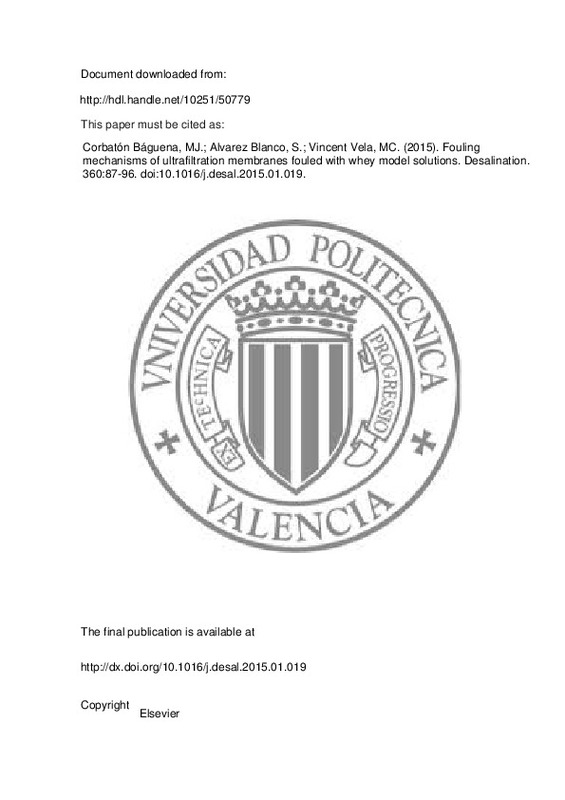JavaScript is disabled for your browser. Some features of this site may not work without it.
Buscar en RiuNet
Listar
Mi cuenta
Estadísticas
Ayuda RiuNet
Admin. UPV
Fouling mechanisms of ultrafiltration membranes fouled with whey model solutions
Mostrar el registro sencillo del ítem
Ficheros en el ítem
| dc.contributor.author | Corbatón Báguena, María José
|
es_ES |
| dc.contributor.author | Alvarez Blanco, Silvia
|
es_ES |
| dc.contributor.author | Vincent Vela, Maria Cinta
|
es_ES |
| dc.date.accessioned | 2015-05-26T12:10:49Z | |
| dc.date.available | 2015-05-26T12:10:49Z | |
| dc.date.issued | 2015-03-16 | |
| dc.identifier.issn | 0011-9164 | |
| dc.identifier.uri | http://hdl.handle.net/10251/50779 | |
| dc.description.abstract | In this work, three ultrafiltration (UF) membranes with different molecular weight cut-offs (MWCOs) and made of different materials were fouled with several whey model solutions that consisted of bovine serum albumin (BSA) (1% w/w), BSA (1% w/w) and CaCl2 (0.06% w/w in calcium) and whey protein concentrate (WPC) with a total protein content of 45% w/w at three different concentrations (22.2, 33.3 and 44.4 g·L− 1). The influence of MWCO and membrane material on the fouling mechanism dominating the UF process was investigated. Experiments were performed using two flat-sheet organic membranes and a ceramic monotubular membrane whose MWCOs were 5, 30 and 15 kDa, respectively. Hermia's models adapted to crossflow UF, a combined model based on complete blocking and cake formation equations and a resistance-in-series model were fitted to permeate flux decline curves. The results demonstrated that permeate flux decline was accurately predicted by all the models studied. However, the models that fitted the best to permeate flux decline experimental data were the combined model and the resistance-in-series model. Therefore, complete blocking and cake formation were the predominant mechanisms for all the membranes and feed solutions tested. | es_ES |
| dc.description.sponsorship | The authors of this work wish to gratefully acknowledge the financial support of the Spanish Ministry of Science and Innovation through the project CTM2010-20186. | en_EN |
| dc.language | Inglés | es_ES |
| dc.publisher | Elsevier | es_ES |
| dc.relation.ispartof | Desalination | es_ES |
| dc.rights | Reserva de todos los derechos | es_ES |
| dc.subject | Ultrafiltration | es_ES |
| dc.subject | Whey model solutions | es_ES |
| dc.subject | Mathematical models | es_ES |
| dc.subject | Fouling mechanisms | es_ES |
| dc.subject.classification | INGENIERIA QUIMICA | es_ES |
| dc.title | Fouling mechanisms of ultrafiltration membranes fouled with whey model solutions | es_ES |
| dc.type | Artículo | es_ES |
| dc.identifier.doi | 10.1016/j.desal.2015.01.019 | |
| dc.relation.projectID | info:eu-repo/grantAgreement/MICINN//CTM2010-20186/ES/TECNICAS NO CONVENCIONALES PARA LA LIMPIEZA DE MEMBRANAS DE ULTRAFILTRACION APLICADAS EN LA INDUSTRIA ALIMENTARIA/ | es_ES |
| dc.rights.accessRights | Abierto | es_ES |
| dc.contributor.affiliation | Universitat Politècnica de València. Departamento de Ingeniería Química y Nuclear - Departament d'Enginyeria Química i Nuclear | es_ES |
| dc.contributor.affiliation | Universitat Politècnica de València. Instituto de Seguridad Industrial, Radiofísica y Medioambiental - Institut de Seguretat Industrial, Radiofísica i Mediambiental | es_ES |
| dc.description.bibliographicCitation | Corbatón Báguena, MJ.; Alvarez Blanco, S.; Vincent Vela, MC. (2015). Fouling mechanisms of ultrafiltration membranes fouled with whey model solutions. Desalination. 360:87-96. https://doi.org/10.1016/j.desal.2015.01.019 | es_ES |
| dc.description.accrualMethod | S | es_ES |
| dc.relation.publisherversion | http://dx.doi.org/10.1016/j.desal.2015.01.019 | es_ES |
| dc.description.upvformatpinicio | 87 | es_ES |
| dc.description.upvformatpfin | 96 | es_ES |
| dc.type.version | info:eu-repo/semantics/publishedVersion | es_ES |
| dc.description.volume | 360 | es_ES |
| dc.relation.senia | 278893 | |
| dc.contributor.funder | Ministerio de Ciencia e Innovación | es_ES |







![[Cerrado]](/themes/UPV/images/candado.png)

